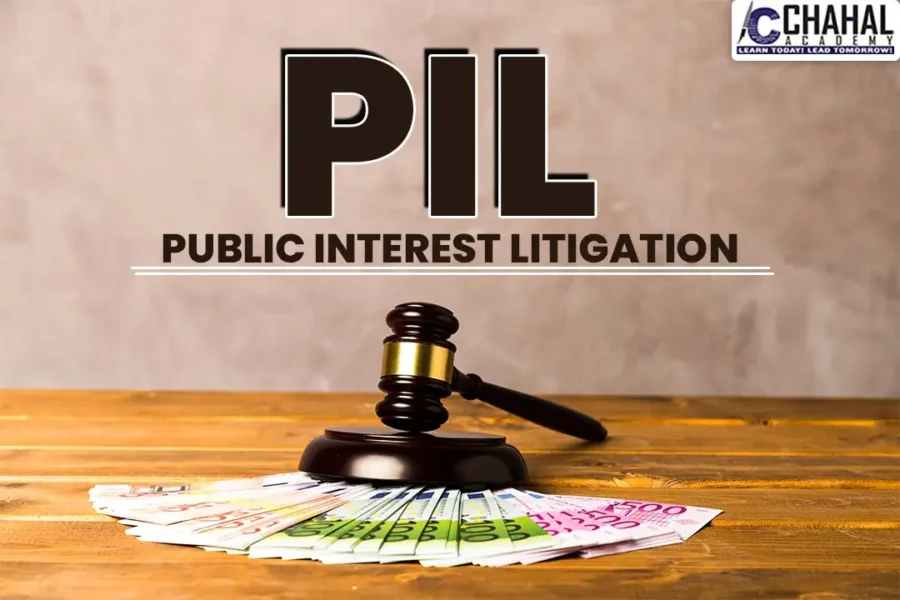The concept of Public Interest Litigation has been borrowed from American jurisprudence. This concept is not defined in any of the acts or statutes. The courts have devised it through interpretations. PIL has empowered the general public to approach the courts through judicial activism. It permits cases affecting large groups, especially disadvantaged communities, to be brought even if the petitioner is not personally harmed. This concept has diluted the principle of Locus Standi, which implies the right of a person to approach the court if their rights are infringed. It commonly addresses matters like human rights abuses, environmental damage, or government negligence.
Any Indian citizen can approach to Supreme Court under Article 32 and the High Court under Article 226. The court has the authority to treat a letter as a writ petition and act upon it, provided it is convinced that certain conditions are met. Specifically, the letter must be sent by either the aggrieved party, a socially conscious individual, or a group engaged in public interest work, and it should seek to uphold legal or constitutional rights of individuals who, due to poverty or disability, are unable to access the court themselves. Additionally, the court may initiate action on the basis of newspaper reports if it finds the matter credible and deserving of judicial intervention.
EVOLUTION OF PIL
- Hussainara Khatoon vs. State of Bihar (1979)
This is the first landmark case which introduced the concept of PIL in India. The petition was filed based on a newspaper report highlighting the plight of undertrial prisoners in Bihar, many prisoners who had been imprisoned for years without trial for minor offences. The Supreme Court held the right to a speedy trial as a Fundamental Right. Around 40,000 undertrial prisoners were released.
- S.P Gupta vs. Union of India (1981)
This case is also known as the Jugdes Transfer Case, this judgment played a pivotal role in the expansion of locus standi. Justice P.N Bhagwati emphasized that when legal wrongs affect a large number of people or disadvantaged groups, any public-spirited individual can approach the court even if they are not personally affected.
- Bandhua Mukti Morcha vs. Union of India (1984)
The PIL was filed by a non-governmental organization fighting against bonded labour. The case brought to light the inhumane working conditions of bonded labourers. The Supreme Court ruled that forced labour violated Article 23 (prohibition of forced labour) and reiterated right to live with dignity under Article 21.
- M.C Mehta vs. Union of India (1987)
Environmental activist and lawyer M.C Mehta filed PIL against the Ganga Pollution Case, the court ordered the closure of polluting tanneries and emphasised the right to clean water under Article 21. The Supreme Court held that, even though the petitioner is not an owner, he is entitled to approach the Court for the enforcement of statutory provisions, as he is an interested party concerned with safeguarding the lives of people who use the waters of the Ganga.
- Vishaka vs. State of Rajasthan (1997)
The Supreme Court issued a comprehensive set of guidelines known as the Vishaka Guidelines to prevent and address workplace harassment. The court held that it violated Article 14,15, and 21.
PROCESS OF FILING PUBLIC INTEREST LITIGATION
Step 1: The individual intending to file a PIL (referred to as the petitioner) should thoroughly research the issue affecting the general public and consult with the relevant people or organizations connected to the matter.
Step 2: The petitioner must gather all relevant data and supporting documents that serve as evidence to substantiate the claims made in the PIL.
Step 3: The PIL should be carefully drafted, including essential details such as the court’s name, names and addresses of both the petitioner and the respondent(s), the constitutional article under which the PIL is being filed, a detailed account of the facts relating to the public issue, and the specific relief or remedy being sought from the court.
Step 4: A copy of the completed PIL must be forwarded to the respondent(s).
Step 5: The PIL is then filed with either the Supreme Court or the respective High Court, along with proof that copies have been served to all respondents. If submitted to the High Court, two copies of the petition must be filed. For the Supreme Court, five copies are required.
IMPORTANCE OF PIL IN PROMOTING SOCIAL JUSTICE
Expansion of access to justice: PIL allows individuals or groups, especially the underprivileged, to approach the courts for the enforcement of fundamental rights even if they are not directly affected.
Judicial activism and Social Justice: The Judiciary has actively intervened in matters concerning social justice, environmental protection, human rights and more.
Accountability of Public Authorities: PIL serves as a tool to hold public institutions accountable for lapses in duty, corruption or violation of constitutional and legal rights.
Strengthening Rule of Law: PIL helps in enforcing the rule of law by compelling the government and its agencies to act within the limits of their authority and uphold constitutional values.
Contributed by: Vanshika Dhiman (Intern)

